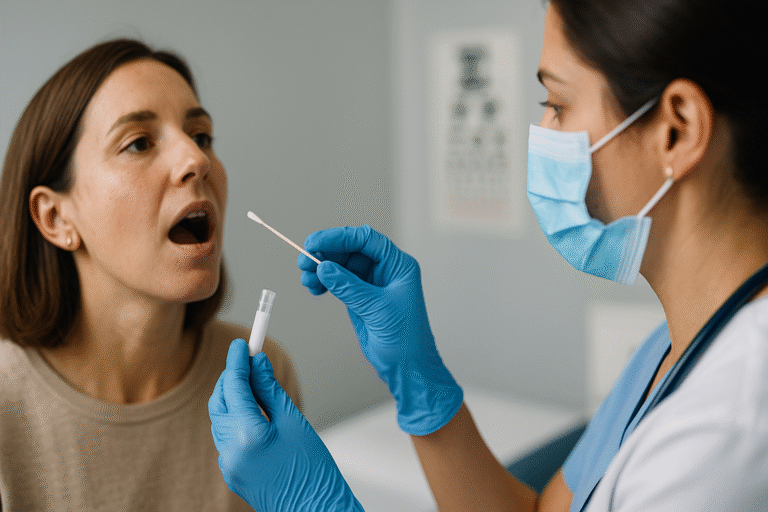
Hawkins Kennedy Test
Introduction
Shoulder pain can blur into daily life, especially with reaching, lifting, or sleeping. The Hawkins Kennedy test helps clinicians quickly screen for subacromial shoulder impingement, a common source of pain from irritated rotator cuff tendons or the subacromial bursa.
In this guide, you’ll learn what the Hawkins Kennedy test checks, how it’s done, what a positive result means, and how accurate it is compared with other exams. You’ll also find rehab basics, red flags, and links to trusted medical sources for deeper reading.
The goal is clarity and action. You’ll understand when the test helps, when it doesn’t, and what to do next if your pain pattern matches shoulder impingement. We keep paragraphs short, the language simple, and the advice practical—so you can move forward with confidence.
What does the Hawkins Kennedy test check?
The Hawkins Kennedy test is a provocation maneuver. It narrows the space beneath the acromion to stress the subacromial tissues, especially the supraspinatus tendon and subacromial bursa.
If this position reproduces your familiar pain at the front or side of the shoulder, it increases the likelihood of subacromial impingement rather than neck, nerve, or other causes.
Think of it as a fast screen, not a final diagnosis. It guides the rest of the exam—strength tests, other impingement signs, and sometimes imaging—so the whole picture becomes clear.
Hawkins Kennedy test (step-by-step)
Clinician method:
- You sit or stand. The shoulder is flexed to 90° and the elbow is bent to 90°.
- The examiner supports your arm to keep muscles relaxed.
- They passively internally rotate your shoulder (move the forearm downward) to compress the subacromial space. Pain during this motion is considered positive.
Good technique matters. The clinician stabilizes the scapula and compares both sides to avoid false signals from stiff posture or guarding. The aim is to reproduce your typical pain, not to force range or provoke new pain.
Hawkins Kennedy test shoulder: what is a positive result?
A positive Hawkins Kennedy test means the maneuver triggers your usual anterior or lateral shoulder pain under the acromion.
Pain at the acromioclavicular (AC) joint can also occur in this position, but that points to AC pathology rather than pure subacromial impingement. Clinicians use palpation and a cross-body adduction test to sort this out.
A positive finding supports subacromial involvement, but it does not prove a rotator cuff tear. Diagnosis comes from the cluster of findings across your history, strength tests, and sometimes imaging.
What does the Hawkins Kennedy test not tell you?
It won’t pinpoint exactly which structure hurts—supraspinatus vs. bursa vs. biceps—because several live in the same small space.
It also can’t grade a tear or show tissue quality. That requires strength testing, ultrasound, or MRI if the clinical picture suggests a significant cuff injury.
In other words, treat it as a directional signpost. It moves the probability, but it isn’t the destination.
Accuracy: how well does the Hawkins Kennedy test perform?
No single shoulder test is perfect. The Hawkins Kennedy test shows moderate sensitivity and modest specificity—useful for screening, not for ruling in a diagnosis by itself.
Meta-analyses report sensitivity around 0.74–0.79 and specificity around 0.57–0.59, meaning a negative test can help rule out impingement, while a positive test needs context from the rest of the exam.
This is why clinicians combine tests. You’ll see Hawkins paired with Neer, Painful Arc, and infraspinatus strength to get a stronger overall signal.
Test clusters beat single tests
Research suggests a cluster can shift probability much more than any test alone.
A well-known study found that Hawkins-Kennedy + Painful Arc + Infraspinatus resistance delivered the best post-test probability (≈95%) for subacromial impingement in their cohort. That’s a big jump in diagnostic confidence.
Clinically, if two or three of these are positive—especially when they reproduce your familiar pain—impingement becomes the leading explanation. If they’re negative, the exam pivots to neck, instability, or other shoulder sources.
Hawkins Kennedy vs. Neer and other shoulder tests
Neer sign is another impingement screen. It elevates the arm to compress the same structures and shows similar moderate accuracy.
Using both increases sensitivity and gives a more rounded view of how the subacromial space behaves during motion. Add Empty Can/Jobe for supraspinatus and Painful Arc for the mid-range pain pattern.
Each test adds a piece to the puzzle. The pattern across tests, plus your history, drives the plan more than any single sign.
Symptoms that fit a positive Hawkins Kennedy pattern
Many people report pain with overhead reaching, dressing, placing items on shelves, or night pain lying on the affected side.
There may be weakness with elevation or external rotation if the cuff is involved. Stiff thoracic posture or long hours at a screen can maintain the compression pattern over time.
If symptoms are traumatic in onset or progress quickly, clinicians raise the index of suspicion for a tear and pivot sooner to imaging.
Can you do the Hawkins Kennedy test at home?
It’s not recommended. It’s easy to over-rotate, irritate the shoulder, or misinterpret discomfort as a meaningful sign.
If you’re in pain, you’ll get better answers from a structured exam that compares sides, controls scapular movement, and runs several tests together.
Instead, focus on safe range of motion, posture, and activity tweaks until you’re seen. The sections below outline simple, low-risk ideas to get started.
First-line care if impingement is suspected (not medical advice)
Modify activity: Temporarily reduce overhead reps, throwing, and painful presses. Shift to angles and loads that feel calm, not provocative.
Exercise therapy: Prioritize rotator cuff and scapular control. Think rowing patterns, external rotation, low-angle scaption, and thoracic mobility. Progress slowly and consistently.
Medication & injections: A short course of NSAIDs (if appropriate) or a subacromial corticosteroid injection can reduce pain in the short-term to enable rehab.
Imaging & referral: If there was trauma, significant weakness, or poor response to rehab, clinicians consider ultrasound or MRI and orthopedic input. Authoritative patient guides: AAOS OrthoInfo.
Red flags: see a clinician promptly
If you can’t raise the arm after an injury, have worsening night pain, progressive weakness, fever, or widespread numbness, get a medical assessment without delay.
These features suggest problems beyond simple impingement and deserve urgent care.
What to expect during a clinic visit
A thoughtful exam starts with history—onset, aggravators, work and sport loads, sleep, and prior injuries.
Then comes a movement screen, followed by clusters of impingement signs (Hawkins, Neer, Painful Arc), and strength tests for supraspinatus and infraspinatus. The goal is a coherent story, not just isolated positives.
If the picture still isn’t clear, your clinician may trial targeted rehab, then reassess. Only if progress stalls or red flags appear will they reach for imaging.
Practical tips to protect the shoulder while you heal
- Swap painful overhead lifts for landmine presses or incline pushes.
- Keep elbows slightly forward of the body during work and sleep for space.
- Use short, frequent bouts of external rotation and scapular retraction as “movement snacks.”
- Nudge posture often—chest open, ribs down, chin long—instead of holding static positions.
These small choices reduce load on sensitive subacromial tissues and make your exercises work harder for you.
FAQs
1) What does the Hawkins Kennedy test test for?
It screens for subacromial shoulder impingement, where rotator cuff tendons and/or the bursa are compressed beneath the acromion. Pain reproduced in this position raises suspicion for this diagnosis.
2) Is a positive Hawkins Kennedy test the same as a rotator cuff tear?
No. It increases the likelihood of subacromial pain, but it does not confirm a tear. Strength tests and, when needed, ultrasound or MRI are used to check tendon integrity.
3) How accurate is the Hawkins Kennedy test?
It’s moderately sensitive and modestly specific, best as part of a cluster with Neer, Painful Arc, and infraspinatus strength. Meta-analyses report sensitivity ~0.74–0.79 and specificity ~0.57–0.59.
Conclusion
The Hawkins Kennedy test is a quick, useful screen for subacromial shoulder impingement, especially when your clinician pairs it with Neer, Painful Arc, and infraspinatus strength.
A positive result means the position reproduced your familiar pain, but the final call relies on the pattern across tests, your history, and sometimes imaging. With the right plan—smart activity changes, cuff and scapular strengthening, and guidance when needed—most people return to pain-free motion.
If shoulder pain is disrupting work, training, or sleep, book a professional assessment and start rehab now.
What’s your experience with the Hawkins Kennedy test? Share below—and check out our guides to the Neer Test and Painful Arc Test next.
Medical disclaimer: Educational content only. Not a diagnosis or treatment plan. If you have persistent pain, progressive weakness, or red-flag symptoms, see a qualified healthcare profe
Stay in touch to get more updates & alerts on sosomodapks! Thank you





